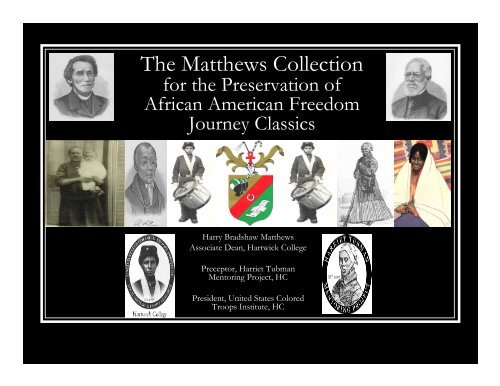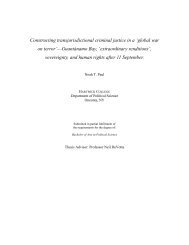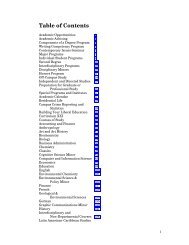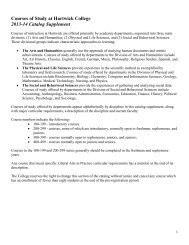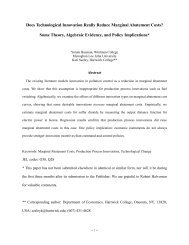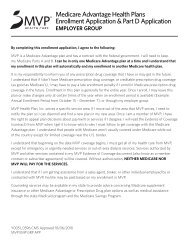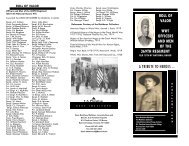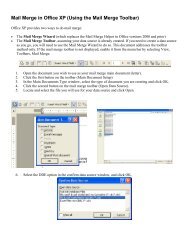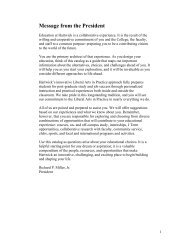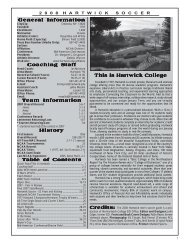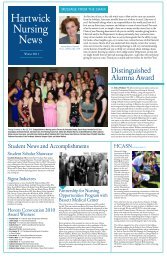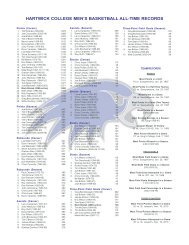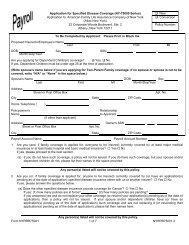The Matthews Collection - Hartwick College
The Matthews Collection - Hartwick College
The Matthews Collection - Hartwick College
You also want an ePaper? Increase the reach of your titles
YUMPU automatically turns print PDFs into web optimized ePapers that Google loves.
<strong>The</strong> <strong>Matthews</strong> <strong>Collection</strong><br />
for the Preservation of<br />
African American Freedom<br />
Journey Classics<br />
Harry Bradshaw <strong>Matthews</strong><br />
Associate Dean, <strong>Hartwick</strong> <strong>College</strong><br />
Preceptor, Harriet Tubman<br />
Mentoring Project, HC<br />
President, United States Colored<br />
Troops Institute, HC
Dedicated to the Remembrance of<br />
African American Forebears<br />
• This power point presentation represents material in the privately owned <strong>Matthews</strong><br />
<strong>Collection</strong> for the Preservation of African American Freedom Journey Classics.<br />
• No items in this presentation can be duplicated or transmitted without the written<br />
permission of Harry Bradshaw <strong>Matthews</strong>.<br />
• U.S. Pluralism Center, 103 Bresee Hall<br />
<strong>Hartwick</strong> <strong>College</strong><br />
Oneonta, New York 13820<br />
• © Harry Bradshaw <strong>Matthews</strong> 2009
<strong>The</strong> <strong>Matthews</strong> <strong>Collection</strong><br />
Supporting the USCT Institute<br />
<strong>The</strong> <strong>Matthews</strong> <strong>Collection</strong> is a privately owned collection consisting of more than<br />
2,500 items, primarily first edition books about African Americans, with some<br />
lithographs, newspaper illustrations, and coins. Also included are the writings of<br />
Harry Bradshaw <strong>Matthews</strong> that pertain to the Freedom Journey.<br />
<strong>The</strong> <strong>Matthews</strong> <strong>Collection</strong> is used for:<br />
Gallery Talks – presentations regarding the Civil War, family research, Freedom<br />
Journey, Cato Freedom Project, and related topics.<br />
Field Trips – off-campus visits to preservation sites by interns conducting<br />
historical research.<br />
Exhibitions - items provided for lectures, presentations, and workshops at<br />
<strong>Hartwick</strong> <strong>College</strong> and other sites.<br />
Internet Access – links with the USCT Institute web site at <strong>Hartwick</strong> <strong>College</strong> and<br />
as a part of the offerings of the Cato Freedom Project and the Harriet Tubman<br />
Mentoring Project.
USCT Institute and the Harriet<br />
Tubman Mentoring Project<br />
<strong>The</strong> USCT Institute was established as a membership organization based at<br />
<strong>Hartwick</strong> <strong>College</strong> during October 1998 for the research, preservation, and<br />
remembrance of the 200,000 black soldiers and their 7,000 white officers who<br />
comprised the USCT. <strong>The</strong> Harriet Tubman Mentoring Project was established at<br />
<strong>Hartwick</strong> <strong>College</strong> during September 2007 as the official student branch of the<br />
USCTI. Together, the two entities explore the topics of:<br />
Freedom Journey – Researching, preserving, and commemorating Black<br />
Revolutionary War Patriots, Anti-Slavery Sentiments, Abolitionist Actions,<br />
Underground Railroad, USCT, and the Civil War.<br />
Local History and Family Research – Studying primary documents, census<br />
indices, and genealogical pursuits.<br />
Post-Reconstruction Through World War II – Following the Freedom<br />
Journey through Reconstruction and into military history during the Spanish-<br />
American War, World War I and World War II.<br />
African American History – Researching, collecting, and studying the history of<br />
Africans in America, inclusive of the United States, Canada, and the Caribbean<br />
countries.
<strong>The</strong> <strong>Hartwick</strong> <strong>College</strong> Connection:<br />
Rev. John Lawyer’s Franckean Synod<br />
and Congressman Isaac Newton Arnold<br />
Bishop Daniel Alexander Payne
Freedom Journey<br />
• Black Revolutionary War Patriots<br />
• Anti-Slavery Sentiments<br />
• Abolitionist Actions<br />
• Underground Railroad<br />
• Enlistment of the United States<br />
Colored Troops<br />
• Self Help Proclamations and Actions
Resistance and Liberation of Enslaved<br />
Americans Through the Civil War<br />
• Enlistment of black men into the British forces and the<br />
Continental Army during the Revolutionary War<br />
• Slave Revolts<br />
• Establishment of Independent Churches<br />
• Establishment of Secret Societies<br />
• Establishment of Newspapers<br />
• Classically Trained Men of African Descent<br />
• Declaration of an Identity as Colored Americans<br />
• Writings to Define the History of Africans in America<br />
• Underground Railroad<br />
• Establishment of a <strong>College</strong> for people of African<br />
Descent<br />
• Enlistment of United States Colored Troops
“Do You Know My Name?”<br />
Some Autobiographical and Biographical Images
“Do You Know My Name?”<br />
Some Autobiographies and Biographies<br />
From the Virginia Plantation to the National Capital,<br />
John Mercer Langston, 1894.<br />
Life of Jacob Hodges, A.D. Eddy, 1842.<br />
Life and Public Services of Martin R. Delany, Frank A.<br />
Rollin, 1883.<br />
Life of Toussaint L’Ouverture, John R. Beard, 1853.<br />
Narrative of the Life and Travels of Mrs. Nancy Prince,<br />
1856.<br />
Story of Archer Alexander: From Slavery to Freedom,<br />
William G. Eliot, 1885.<br />
Sketches of the Life and Character of the Reverend<br />
Lemuel Haynes, A.M., Mather Cooley, 1839.<br />
Truth Stranger Than Fiction: Father Henson’s Story,<br />
Josiah Henson, 1858.<br />
Twenty-Two Years a Slave and Forty Years a Freeman,<br />
Austin Steward, 1861.<br />
Twelve Years a Slave, Solomon Northup, 1853.
“Do You Know My Name?”<br />
Some Autobiographies and Biographies<br />
• In Memoriam: Isaac Newton Arnold, Nov. 30, 1813-Apr. 24, 1884.<br />
Arthur Mason Arnold, May 13, 1838-Apr. 26, 1873, 1885.<br />
• A Head of Her Time: Abby Kelley and the Politics of Antislavery,<br />
Dorothy Sterling, 1991.<br />
• American Statesman: Thaddeus Stevens, Samuel W. McCall, 1899.<br />
• Autobiography of Horace Greeley, or Recollections of a Busy Life,<br />
Horace Greeley, 1872.<br />
• Life of William H. Seward with Selections from His Works<br />
• George E. Baker, 1855.<br />
• Public Life of Capt. John Brown, with an Auto-Biography of the<br />
Childhood and Youth, James Redpath, 1860.<br />
• A Woman's Life-Work: Labors and Experiences, Laura S Haviland,<br />
1881.<br />
• “Harriet Tubman,” <strong>The</strong> Anglo-African, 1863.
• Black Achievers at the Time of the Emancipation<br />
Proclamation – William Wells Brown, Black Man, 1863<br />
• Benjamin Banneker Ira Aldridge* Crispus Attucks Edwin M. Bannister Jean<br />
Pierre Boyer Henry Bibb Capt. Callioux Joseph Cater<br />
Alexander Crummell* Dessalines Henri Christophe Frederick Douglass<br />
William Douglass Placido Charlotte L. Forten George T. Downing<br />
Madison Washington Robert Morris Alexander Dumas Martin R. Delany*<br />
Leonard A Grimes Joseph Jenkins Pres. Geffrard John Mercer Langston*<br />
Henry Highland Garnet William C. Nell Toussaint L’Overture Sir. Edward Jordan<br />
Jeremiah B. Sanderson James Lawson Daniel A. Payne J. <strong>The</strong>odore Holly<br />
James M’Cune Smith Robert Small William J. Wilson John Sella<br />
• James WC Pennington Capt. Joseph Howard Andre Rigaud Nat Turner<br />
Martin Elymas Payson Rogers Charles L. Reason Alexander Petion<br />
William H. Simpson Ex-Pres.Roberts Robert Purvis CharlesLenox Remond<br />
John S. Rock George B. Vashon Denmark Vesey Samuel R. Ward<br />
Frances Ellen Watkins Phyllis Wheatley William Still* James M. Whitfield
History and Genealogy Writings<br />
Harry Bradshaw <strong>Matthews</strong><br />
• African American Freedom Journey in New York and Related Sites, 1823-1870, Freedom<br />
Knows No Color, Africana Homestead Legacy Publishers, 2008, ISBN 978-0-9799537-3-6,<br />
World Cat Accession Number: 214322630.<br />
• African American Genealogical Research: How to Trace Your Family History, 1992, revised<br />
2007, World Cat Accession Number: 181336094.<br />
• Cato Freedom Project: Three African American Revolutionary War Patriots in Central New<br />
York, Harry Bradshaw <strong>Matthews</strong>, 2009.<br />
• Family Legacy of Anthony Johnson: From Jamestown, VA to Somerset, MD 1619-1995: A<br />
Multi-Racial Saga in Black, Red and White : <strong>The</strong> Negro Johnson and Indian Puckham lineage,<br />
1992, revised 2007, World Cat Accession Number: 154311568.<br />
• A Legacy of Ethiopia: <strong>The</strong> African-American Identity, 1989, World Cat Accession Number:<br />
38346823.<br />
• Re-visiting the Battle of Gettysburg : <strong>The</strong> Presence of African Americans Before and After the<br />
Conflict : Mid-Atlantic Regional Archives Conference, Gettysburg, Pennsylvania, November 6,<br />
1993, World Cat Accession Number: 31979987.
History and Genealogy Collectibles<br />
in the <strong>Matthews</strong> <strong>Collection</strong><br />
• History of the Colored Race in America, William T. Alexander, 1887.<br />
• History of the Negro Race in America from 1619 to 1880, Vol. 1, George<br />
Washington Williams, 1885.<br />
• Men of Mark: Eminent, Progressive and Rising, William J. Simmons, 1887.<br />
• Negro Builders and Heroes, E.M. Brawley, 1937.<br />
• <strong>The</strong> Negro in American History, John W. Cromwell, 1914.<br />
• Progress of a Race: <strong>The</strong> Remarkable Advancement of the<br />
Afro-American Negro, H.F. Kletzing and W.H. Crogman, 1898.<br />
• A School History of the Negro Race in America: From 1619 to<br />
1890, Edward A. Johnson, 1892.<br />
• <strong>The</strong> Story of a Rising Race: <strong>The</strong> Negro in Revelation, in History<br />
and in Citizenship, J.J. Pipkin, 1902.<br />
• <strong>The</strong> United Negro: His Problems and His Progress, Intro. by<br />
Bishop W. J. Gaines, 1902.
Booker T. Washington and<br />
W.E.B. DuBois Collectibles<br />
• A New Negro for a New Century, Booker T. Washington, 1900.<br />
• My Larger Education, Booker T. Washington, 1911.<br />
• <strong>The</strong> Negro in Business, Booker T. Washington, 1907.<br />
• <strong>The</strong> Story of My Life: an Autobiography, Booker T. Washington,<br />
1901.<br />
• <strong>The</strong> Story of the Negro: Rise of the Race from Slavery, Booker T.<br />
Washington, 1909.<br />
• Tuskegee & Its People: <strong>The</strong>ir Ideals and Achievements, Booker T.<br />
Washington, 1906.<br />
• Up from Slavery, Booker T. Washington, 1901.<br />
• Working with the Hands, Booker T. Washington, 1904.<br />
• Color and Democracy: Colonies and Peace, W.E.B. DuBois, 1945.<br />
• <strong>The</strong> Souls of Black Folk, W.E.B. DuBois, 1903.
Collectibles of Carter Godwin Woodson<br />
and Colleagues<br />
• <strong>The</strong> Education of the Negro, Carter Godwin Woodson, 1919.<br />
• <strong>The</strong> History of the Negro Church, Carter Godwin Woodson, 1921.<br />
• <strong>The</strong> Negro in Our History, Carter Godwin Woodson, 1922.<br />
• Negro Orators and <strong>The</strong>ir Orations, Carter Godwin Woodson, 1925.<br />
• Free Negro Heads of Families in the United States in 1830, Carter<br />
Godwin Woodson, 1925.<br />
• Free Negro Owners of Slaves in the United States in 1830, Carter<br />
Godwin Woodson, 1924.<br />
• Black Manhattan, James Weldon Johnson, 1930.<br />
• Home to Harlem, Claude McKay, 1928.<br />
• God’s Trombones, James Weldon Johnson, 1927.<br />
• <strong>The</strong> Negro in the Caribbean, Eric Williams, 1942.<br />
• <strong>The</strong> New Negro: An Interpretation, Alain Locke, 1925.<br />
• <strong>The</strong> Old Negro and the New Negro, T. Leroy Jefferson, 1937.
Miscellaneous Treasures<br />
in the <strong>Matthews</strong> <strong>Collection</strong><br />
• An Anthology of Some of the Public Utterances of His<br />
Imperial Majesty, Haile Selassie I, Author Unknown, 1949.<br />
• <strong>The</strong> Black Border: Gullah Stories of the Carolina Coast,<br />
Ambrose E. Gonzales, 1922.<br />
• A Pictorial History of the Negro in the Great World War 1917-<br />
1918, Mme. Touissant Welcome, 1919.<br />
• Ethiopia and the Missing Link inAfrican History, Sterling M.<br />
Mean, 1945.<br />
• <strong>The</strong> History of Alpha Phi Alpha: A Development in Negro<br />
<strong>College</strong> Life, Charles H. Wesley, 1950.<br />
• Haile Selassie: Emperor of Ethiopia, Princess Asfa Yilma,<br />
1936.<br />
• Iola Leroy or Shadows Uplifted, Frances E.W. Harper, 1892.<br />
• Rasselas, Prince of Abyssinia, Samuel Johnson, 1889.
Sample External Influences<br />
• 1553 – England enters slave trade.<br />
• 1562 – Sir John Hawkins was the first<br />
Englishman to transport slaves to the<br />
Americas.<br />
• 1772- James Somerset Case ends slavery in<br />
England; terms of the Magna Charta used as<br />
explanation for ending slavery.<br />
• 1803 - Toussaint L’Ouverture led successful<br />
Haitian revolt against France’s Emperor<br />
Napoleon.
Africa and Slavery:<br />
A Justification<br />
• Africa and the American Flag, Andrew H. Foote, 1854.<br />
• American Slavery Distinguished from the Slavery of English <strong>The</strong>orists<br />
and Justified by the Law of Nature, Rev. Samuel Seabury, 1861.<br />
• Bible Defence of Slavery, Josiah Priest, 1852.<br />
• Captain Canot: Twenty Years of an African Slaver, Brantz Mayer, 1854.<br />
• Lights and Shadows of African History, Peter Parley, 1849.<br />
• History of Slavery and the Slave Trade, Ancient and Modern, W.O.<br />
Blake, 1860.<br />
• A Journey to Central Africa; Life and Landscapes from Egypt to the<br />
Negro Kingdoms of the White Nile, Bayard Taylor, 1860.<br />
• <strong>The</strong> Negro Servant, Legh Richmond,1876.<br />
• Negro Servant: Communicated by A Clergyman of the Church of<br />
England, Philadelphia: Sunday and Adult School Union, 1820.<br />
• Scenes in Africa for the Amusement and Instruction of Little Tarry-At-<br />
Home Travellers, Rev. Isaac Taylor, 1820.
Revolutionary War<br />
• American Revolution in New York, Division of Archives and History, Albany: University<br />
of the State of New York, 1926.<br />
• Battles of the United States by Sea and Land, Henry B. Dawson, 1858.<br />
• Cato Freedom Project: Three African American Revolutionary War Patriots in Central<br />
New York, Harry Bradshaw <strong>Matthews</strong>, 2009.<br />
• Colored Patriots of the American Revolution, William C. Nell, 1968.<br />
• Connecticut’s Black Soldiers 1775-1783, David O. White, 1973.<br />
• Forgotten Patriots: African American Indian Patriots in the Revolutionary War, Eric<br />
Grundset, National Society Daughters of the American Revolution, 2008.<br />
• History of the American Revolution, Vol II, David Ramsay, 1811.<br />
• <strong>The</strong> Negro in the American Revolution, Herbert Aptheker, 1940.<br />
• <strong>The</strong> Negro in the American Revolution, Benjamin Quarles, 1961.<br />
Men of Color at the Battle of Monmouth, June 28, 1778, Richard S. Walling, 1994.<br />
• New York in the Revolution as Colony and State, James A Roberts, 1898.<br />
• Rhode Island Historical Tracts No. 10 in Historical: Attempts to Raise A Regiment of<br />
Slaves in Rhode Island, Jeremiah Olney, 1880.<br />
• Virginia Negro Soldiers and Sailors in the Revolutionary War, Luther Porter Jackson, 1944.
Legacy of Cato Freedom<br />
• He was born in 1734 in Africa.<br />
• He enlisted in Captain Sheldon or Douglass Company,<br />
Col. S.B. Webb’s Third Regiment Connecticut<br />
Line in 1778 for three years.<br />
• He appeared on New York’s Veteran Roll in 1818.<br />
• He resided in Burlington Township, Otsego County, NY<br />
in 1820, owning 33 acres of land and was married to<br />
53-year-old Parmelia [Amelia]; daughters were 15-year-old<br />
Charlotte and 13-year-old Aurabia.<br />
• Cato Freeman was the name inscribed on his tombstone<br />
at the Butternut Valley Cemetery.<br />
• <strong>The</strong> date of death recorded on his tombstone was May 19, 1828.<br />
• Cato Freedom was the name recorded in his pension file with<br />
the date of death recorded as February 13, 1830.
Legacy of Primus Hill<br />
• A Black patriot, also known as Ebenezer Hill, was born<br />
about 1750.<br />
• He enlisted in Captain Benjamin Throop’s Company,<br />
Colonel Burrall’s Connecticut Regiment in the winter<br />
of 1775 and 1776 fighting in the relief of the army in<br />
Canada; he was discharged at Fort Independence in<br />
February, 1777.<br />
• His pension application was filed on March 14, 1820 at<br />
70 years of age.<br />
• He resided in Augusta, Oneida County, New York in<br />
1821 with his 70-year-old wife Tamer and three<br />
granddaughters, 7-year-old Phebe, 5-year-old Jewell,<br />
and 2-year-old Jane.
Advocacy and Slave Revolts<br />
• Haitian Revolution: Celebrating the First Black Republic, Charles<br />
L. Blockson, 2004.<br />
• Journal of the Life and Travels of John Woolman, 1824.<br />
• John Brown and His Men, Richard J. Hinton, 1894.<br />
• Negro Slave Revolts in the United States: 1526-1860, Herbert<br />
Aptheker, 1939.<br />
• Negro Versus Equality, 1762-1826, Edited by Winthrop D.<br />
Jordan, 1969.<br />
• Proceedings and Debates of the Convention of the<br />
Commonwealth of Pennsylvania to Propose Amendments to the<br />
Constitution, Commenced at Harrisburg, May 2, 1838, Reported<br />
by John Agg, 1838.<br />
• Short Notes on the Dred Scott Case, J.T. Brooke, 1861.<br />
• Underground Railroad, Charles L. Blockson, 1987.<br />
• White Slave: A Vivid Picture of Slave Life in America, Richard<br />
Hildreth, 1852.
Abolition Actions<br />
• Ahead of Her Time, Abby Kelley and the Politics of Anti-Slavery,<br />
Dorothy Sterling, 1991.<br />
• Ain't I A Woman and A Sister, United States of America, Coin,<br />
1838.<br />
• Am I Not A Man and Brother, Great Britain, Coin, 1700’s.<br />
• Black Abolitionists, Benjamin Quarles, 1969.<br />
• <strong>The</strong> Overthrow of American Slavery, William G. Queal, 1885.<br />
• Recent Speeches and Addresses by Charles Sumner, Charles<br />
Sumner, 1856.<br />
• Report of the Third Anniversary of the Ohio Anti-Slavery Society,<br />
Held in Granville, Licking County, Ohio on the 30th of May 1838,<br />
Ohio Anti-Slavery Society, 1838.<br />
• Results of Emancipation, Augustin Cochin, translated by Mary L.<br />
Booth, 1864.<br />
• Underground Railroad: Revised Edition, William Still, 1878.<br />
• Underground Railroad: From Slavery to Freedom, Wilbur H.<br />
Siebert, 1898.
Development of the Black<br />
Infrastructure<br />
• Climbing Jacob’s Ladder: <strong>The</strong> Rise of Black Churches in Eastern<br />
American Cities, 1740-1877, Edward D. Smith, 1988.<br />
• <strong>The</strong> Condition, Elevation, Emigration, and Destiny of the Colored People of the<br />
United States, Martin Robinson Delany, 1852.<br />
• Education of the Negro Prior to 1861, Carter G. Woodson, 1919.<br />
• History of the African Methodist Episcopal Church, Daniel A. Payne, 1891;<br />
facsimile, 2002.<br />
• History of the Colored Race in America, William T. Alexander, 1887.<br />
• History of the Negro Church, Carter G. Woodson, 1921.<br />
• History of the Negro Race in America, Vol. 1, George W. Williams, 1885.<br />
• Past and Present Condition and the Destiny of the Colored Race: A Discourse<br />
Delivered at the Fifteenth Anniversary of the Female Benevolent Society of Troy,<br />
N.Y., Feb. 14, 1848, Henry Highland Garnet, 1848; a facsimile of the copy at Fisk<br />
University Library, 1969.<br />
• Text Book of the Origin and History of the Colored People, James W.C.<br />
Pennington, 1841; a facsimile, 1969.
Chronology of an Organized Resistance<br />
to Slavery in the United States<br />
• 1784 - Grand Lodge of the Prince Hall Masons founded in MA.<br />
• 1793 - Upper Canada [Ontario] led by Lieutenant-Governor John Graves Simcoe<br />
passed legislation “to prevent the introduction of slavery.”<br />
• 1794 - African Methodist Episcopal Church was founded at the home of Richard<br />
Allen in Philadelphia: James Varick founded the AME Zion in 1796.<br />
• Article 6: AME “That although we consider every child of God a member of the<br />
mystical body of Christ, yet in the political government of the Church, we do prohibit<br />
our white brethren from electing or being elected into any office among us, save that<br />
of a preacher or speaker.”
Religious Independence<br />
• 1808 - Congress prohibited further importing of slaves.<br />
• 1808 - Abyssinian Baptist Church established by Rev.<br />
Thomas Paul in New York City, along with African<br />
American and Ethiopian merchants.<br />
• 1813 - Union Methodist Church of Delaware became<br />
first to effect an organization separate from whites<br />
[Wilmington].<br />
• 1815 - Church Conference in effort to unite AME,<br />
AME Zion, and Union Methodist of Delaware; decision<br />
to remain with individual governances.<br />
• 1815-16 - <strong>The</strong> AME Church and AME Zion Church<br />
became official during these years.<br />
• 1827 - Prince Hall Masons completely separated from<br />
white Masons.
Voices Advocating Actions<br />
• 1829 – David Walker’s Appeal to the Colored Citizens of the World called for armed<br />
resistance to slavery. Maria Stewart was his protégé.<br />
• 1830 – Colored Men’s Convention in Philadelphia was led by AME Bishop Richard<br />
Allen as president and Austin Steward of Rochester, New York as vice president..<br />
• 1831 - Nat Turner slave revolt in Virginia aroused panic among whites throughout<br />
the South.<br />
• 1831 - Colored Men’s Convention advocated for establishing a college in Connecticut<br />
and also for some brethren to relocation to Canada West.<br />
• 1832 - Colored Men’s Convention reported that Connecticut citizens voted against a<br />
college for colored persons and that while 2,000 black persons had migrated to<br />
Canada living on 500 acres, a backlash was occurring among Canadians. A call was<br />
made for an end to slavery in Washington, DC.<br />
• 1833 - Colored Men’s Convention reported that Connecticut law banned literary<br />
societies among black people. Members voted against further colonizing in Canada.
Interconnected Actions<br />
•1833 - American Anti-Slavery Society was established, linking smaller<br />
efforts into a major network; local auxiliary groups emerged on county<br />
and state levels.<br />
• 1834 - Slavery abolished in British Empire. English-speaking<br />
territories became havens for escaped Africans from the United States.<br />
Emancipation Day Celebrations were held on August 1st.<br />
• 1834 - Colored Men’s Convention called for the establishment of<br />
moral reform societies and Phoenix Societies at the local level for<br />
advancing morals, literature, and the mechanical arts. General<br />
Superintendent of the AME Zion Church at the lead along with Rev.<br />
<strong>The</strong>odore S. Wright of NY’s Shiloh Baptist Church. Resolution passed<br />
petitioning Congress for citizenship for black men.
Educated Leaders Emerge<br />
• 1834 - William Whipper of Columbia, PA called for the<br />
removal of the words “African” from all organizations and<br />
the similar removal of the word “colored.” <strong>The</strong> proposal<br />
was rejected. Whipper also called for the Convention of<br />
American Moral Reform, with Revolutionary War patriot,<br />
James Forten, Sr, as president.<br />
• 1835 - 24-year-old Daniel Alexander Payne enrolled at the<br />
Gettysburg Lutheran Seminary.<br />
• 1836 - <strong>The</strong> Colored American was the new name for Weekly<br />
Advocate, which was established by Phillip A Bell, with<br />
Samuel E Cornish as editor; donations received from<br />
Gerrit Smith, Arthur Tappan, Lewis Tappan, and others.<br />
• 1836 - Dr. James McCune Smith completed medical<br />
studies at the University of Glasgow, Scotland.
Scholars of the<br />
Leadership Council<br />
• 1837 - Daniel A. Payne completed studies at the Gettysburg Lutheran Seminary and was<br />
licensed by the abolitionist Franckean Synod [Lutheran] of Otsego County, NY. He<br />
pastured at the Colored Presbyterian Church in East Troy, NY. Payne headed up the<br />
Mental and Moral Improvement Society in Troy. He was heralded by the Colored American<br />
as a scholarly advocate of the darker brethren.<br />
• Other college-educated black men before the Civil War included John B. Russworm of<br />
Bowdoin <strong>College</strong>, Rev. Wright from the Princeton <strong>The</strong>ological Seminary, and Edward<br />
Mitchell from Dartmouth <strong>College</strong>. Doctor James McCune Smith graduated from the<br />
University of Glasgow, Scotland. Edward Jones graduated from Amherst <strong>College</strong> in 1826.<br />
• Martin R. Delany studied at Jefferson <strong>College</strong>. Charles Bennett Ray was educated at the<br />
Wesleyan Academy and briefly at Wesleyan University. Alexander Crummell graduated<br />
from Cambridge University in England.<br />
• Black graduates of Oneida Institute in NY included Henry Highland Garnet, Alexander<br />
Crummell, Jermain W. Loguen, and William H. Allen. <strong>The</strong> University Hiedleburg,<br />
Germany, conferred the degree of Doctor of Divinity upon the Rev. James William<br />
Charles Pennington. Middlebury <strong>College</strong> conferred the A.M. degree upon Lemuel Haynes.
Publishing Opinions<br />
• 1837 - William Whipper of Columbia, PA wrote a<br />
essay, “On Non-Resistance to Offensive<br />
Aggression,” to which editors of the Colored<br />
American responded:<br />
• “We publish this address with pleasure, hoping our<br />
readers will make the most of all the principles and<br />
arguments presented in favor of universal “peace; peace;”<br />
But, we honestly confess that we have yet to learn<br />
what virtue there would be in using moral weapons,<br />
in defense against a kidnapper or a midnight raider.”<br />
• 1837- David Ruggles, a free CT-born man, moved<br />
to NYC. During 1837, he served as secretary of the<br />
New York Committee of Vigilance, protecting<br />
escaped Africans. He operated a printing plant in<br />
CT and a bookstore that turned out many<br />
pamphlets advocating the overthrow of slavery.
Organizing Groups for Protest<br />
• 183 7 - Women organized the Anti-Slavery<br />
Women’s convention in NYC as the first<br />
women’s political convention in the USA,<br />
with more than 200 black and white delegates<br />
joining together, including black and white<br />
officers. Frances E.W. Harper attended it.<br />
• 1838 - Payne assumed penname of Origen.<br />
He met with Gerrit Smith and Beriah Greene<br />
in NY before relocating to Carlisle, PA<br />
during his year-long illness.<br />
• 1838 – Women’s Anti-Slavery Convention<br />
was held in Philadelphia under massive<br />
protest.
African Civilization Society<br />
in America: Garnet Meets Payne<br />
• 1839 - Henry Highland Garnet, an<br />
escaped African from Maryland, graduated<br />
with honors from the Oneida Institute,<br />
Whitesboro, NY. He became a licensed<br />
preacher, and was later head of Shiloh<br />
Presbyterian Church in NYC. He was an<br />
active member of the Liberty Party.<br />
• Payne delivered antislavery address at the<br />
conference of the Franckean Synod, Ft.<br />
Plain, NY.<br />
• 1840 - Payne relocated to Philadelphia and<br />
opened a school, attracting attention from<br />
the AME Church. Garnet pastured at the<br />
Liberty Street Presbyterian Church, East<br />
Troy, NY.
Split in Anti-Slavery Ranks<br />
• 1840 - State of Maryland passed law banning free<br />
persons of color from traveling in and out of its state.<br />
It was targeted against the resistance and liberation<br />
that free persons of African descent were engaging in<br />
as a means of liberation enslaved brethren. <strong>The</strong><br />
number of slaves decreased in the state from 111.5<br />
thousand in 1810 to 89.7 thousand in 1840.<br />
• American Anti-Slavery Society rejected Abby Kelley<br />
[Garrisonian] as a member of its business committee<br />
on gender lines. <strong>The</strong> Society split, with the American<br />
and Foreign Anti-Slavery Society organized with Gerrit<br />
Smith support, including the endorsement of the<br />
Liberty Party. Soon after, Garrison attempted to gain a<br />
resolution of support from the darker brethren at Rev.<br />
Wright’s church meeting. <strong>The</strong> attempt failed. Black<br />
men emerged as a stronger force in the movement.
Declaration of Independence by<br />
Black Leadership Council<br />
• 1840 - Jamaica Convention Declaration - Thomas Van<br />
Ranselaer of New York, Aaron Wood of Flushing, Rev.<br />
JWC Pennington of Newtown, and William P. Johnson<br />
of New York issued call for a state convention to<br />
address disenfranchisement, being debarred from<br />
higher learning, being insulted by proprietors of public<br />
conveyance, outraged by system of public caste<br />
throughout the community.<br />
• <strong>The</strong> state convention occurred in Albany, New York; it<br />
created resentment among many white abolitionists,<br />
including Gerrit Smith, Garrison, etc.<br />
• Convention was also opposed by Dr. Smith because it<br />
was limited to black men, but he attended. Austin<br />
Steward of Rochester was elected President of the<br />
Convention, which was held in Albany, NY.
Colored Men’s Convention<br />
Albany, New York 1840<br />
• New York – Rev. <strong>The</strong>o. S. Wright, Rev. C.B. Ray, Chas. L. Reason, Alexander Crummell,<br />
Frederick Olney, Henry Williams, Patrick H. Reason, Wm. R. Thompson, Jeffery Van Clief, J.H.<br />
Bishop, John M. Dolan, William P. Johnson, Thomas Jefferson. Kings – Benjamin Cruger,<br />
Augustus Washington, Brooklyn. Queens – Samuel V. Berry, Jamaica, Edward M. Africanus,<br />
Flushing. New York – John J. Zuille, George Lawrence, Sr., Frederick Olney, Charles L.<br />
Reason, Charles B. Ray, Patrick H. Reason, Alexander Elston, James Fields, Timothy Seaman,<br />
William P. Johnson. Westchester - John Dungee, Sing Sing, Orange – John Van Huesen,<br />
Sanford Hunter. Duchess – Uriah Boston, Nicholas H. Simons, John N. Mars, Poughkeepsie.<br />
Ulster – Thomas Harley, Kingston. Green – Martin Cross, Catskill. Van Rensselaer – William<br />
Rich, James A. Furbord, Troy. Albany – Charles S. Morton, Henry R. Crummell, J.F. Murray.<br />
Washington – John Harris, Whitehall. Otsego – Henry Granger, Cooperstown. Oneida –<br />
William D. Anderson, Utica. Madison – Samuel R. Ward, Petersboro. Onondago – Ambrose<br />
Dunbar, John Chester, Syracuse. Schenectady – R.P.G. Wright, Schenectady. Tioga –Luther<br />
Johnson, Owego. Tompkins – Henry Jackson, Ithaca. Herkimer – William Johnson, Little<br />
Falls. Livingston – John Crawford, Charles McGayner, Genesee. Seneca – Thomas James,<br />
Seneca Falls. Jefferson – Julius Terrill, Sacketts Harbor. Ontario – J.W. Duffin, Geneva, David<br />
Ray, Canandaigus. Monroe – Austin Steward, Rochester. Erie – Abner H. Francis, George<br />
Ware, Buffalo. Steuben – Simon Watkins, L. Platt, Bath. Allegany – John Peterson, Scio, Isaish<br />
Hough, Friendship. Wayne – P. Lee, William Bristol, Palmyra. Orleans – Richard Gardner,<br />
Medina. Niagara – James Morgan, Nathan Blount, Lockport. Oswego - T.E. Grant, Oswego.<br />
Cortland – William Simmons, Cortland Village. Broome – Charles Spruce, Binghamton.
Election of Delegates:<br />
Colored Men’s Convention – 1840<br />
• Albany – Rev. John T. Raymond, Eli N. Hall, Chas. S. Morton, William H. Topp, David<br />
Thomas, Michael Dougee, James F. Murray, Jacob Waldron, Primus Robinson, F. Van Vranken,<br />
A. Johnson, Henry R. Crummell, John Springsteal, Stephen Myers, Richard Thompson, M.<br />
Thompson, William Johnson, Henry Jackson, Wm. Queen, Henry Johnson, Samuel Streeter,<br />
James Baltimore, Nicholas Bogart, Oliver King, R. Springsteal, Benjamin Cutler, Hiram Dalton,<br />
John Tate, Adam Blake, Eli Johnson, H. Emery, J. Lain.<br />
• Troy – Alex Thuey, Wm. Rich, J.A. Hubbard, Francis Baker, Jacob Brown, Francis L. Allen,<br />
Ezekiel George, H. Highland Garnet, Samuel Jefferson, Lewis Jones, George B. Moulton,<br />
George H. Baltimore, Prince Vaneller, Rev. Robert Butler, William Garrison, F. Thompson,<br />
Anthony Schuyler, Clarence P. Seldon, Rev. George Garnet, Abram Jackson, James Gardner,<br />
Moses F. Van Leer, Daniel Jones, J. Woods, Jesse Prince.<br />
• Schenectady – R.P.G. Wright, Francis Simson, F. Jackson, John Wendell, Richard Sampson,<br />
Francis Dana, T. Harris, Moses Wilcox, S. Barnes, G. Murray, M. Miner, Francis Thompson, J.<br />
Thompson, Francis La Tour, R. Murray.<br />
• West Troy - York La Tour. Lansingburgh – Andrew Grant, Frisby Way, John Jamieson,<br />
George Baker, Chas. Sherman, Chas. Shim, Augustus Gifford, Thomas Van Brankers, George<br />
Lansen, John Johnson, Daniel Oliver.
Emergence of Multiple Aspects of the<br />
African American Infrastructure<br />
• 1841 - James W.C. Pennington, an escaped African<br />
from Maryland, and later pastor of the African<br />
Congregational Church in Hartford, CT, published<br />
his book, A Text Book of the Origin and History<br />
of the Colored People. He received his Doctorate<br />
of Divinity degree at the University of Heidelberg.<br />
• 1841 - Maryland passed law banning black men<br />
from belonging to secret societies, being Afraid<br />
that the African Grand Lodge of the Prince Hall<br />
Masons would gain strong inroads in the state.<br />
• AME Church established newspaper, African<br />
Methodist Episcopal Church Magazine.<br />
• 1842 - Jermain Wesley Loguen, an escaped African<br />
from Tennessee, studied at Oneida Institute,<br />
ordained a minister AME Zion, Syracuse. He was<br />
“Superintendent of the Underground Railroad.”
Frederick Douglass’ Emergence:<br />
Meets Garnet and Payne<br />
• 1842 - Frederick Douglass lectured for the<br />
American Anti-Slavery Society; he visited<br />
Rochester, New York.<br />
• Garnet start. two newspapers in Troy,<br />
NY; National Watchman and the Clarion.<br />
He was a Liberty Party member. Stephen<br />
Meyers in Albany, NY established the<br />
Northern Star and Freeman’s Advocate.<br />
• 1842 - Daniel A. Payne joined Bethel<br />
AME in Philadelphia. Western Citizens of<br />
Chicago indicated that Fort Malden,<br />
Canada had $400,000 worth of former<br />
enslaved Americans residing there.
Split Among Black Abolitionists<br />
• 1843 - Henry Highland Garnet, then 27-years of age, gave an<br />
oration at the Buffalo Convention of Colored men. Included<br />
among those in attendance were Frederick Douglas, William<br />
Wells Brown, Charles B. Ray, and Charles L. Remond.<br />
Garnet’s stated resolution, modeled from David Walker’s<br />
1828 Appeal, was defeated by one vote:<br />
• “Brethren, arise, arise! Strike for your lives and liberties.<br />
Now is the day and the hour. Let every slave throughout the<br />
land do this, and the days of slavery are numbered. You<br />
cannot be more oppressed than you have been - you cannot<br />
suffer greater cruelties than you have already. Rather die<br />
freemen than live to be slaves. Remember that you are four<br />
millions!”<br />
• Frederick Douglass, a Garrisonian, challenged Garnet’s<br />
resolution and won by one vote.
Freedom of the Mind<br />
• 1843 - Martin Delany published the Northern Star, later the Mystery in Philadelphia and<br />
Pittsburgh. Payne was in full association with AME Church, although still listed in the<br />
books of the Lutheran’s Franckean Synod.<br />
• 1843 - Garnet helped organized the Colored Men’s Convention in Albany and gained<br />
the passage of a resolution endorsing the Liberty Party, as a direct affront to the<br />
Garrisonian principles.<br />
• 1846 - Frederick Douglass’ book, Narrative of the Life of Frederick Douglass was a<br />
big hit in England.<br />
• 1847 - Frederick Douglass began publishing his newspaper, North Star, at the AME<br />
Zion Church in Rochester and with the help of Delany.<br />
• 1848 - Free Soil Convention brought together members of Free Soil Party and<br />
Liberty Party.
Ethnic Identity Intensifies<br />
• 1849 - Delany left the North Star. Douglass proclaim, “I thank<br />
God for making me a man; Delany thanks God for making him a<br />
black man.”<br />
• 1849 - Harriet Tubman escaped from slavery in Maryland.<br />
Pennington writes the Fugitive Blacksmith.<br />
• Williams Wells Brown, wrote the book, Anti-Slavery Harps, a<br />
series of poems.<br />
• 1850 - President Millard Fillimore signed the Fugitive Slave Law<br />
that in affect allowed any white man to accuse a black person of<br />
being an escaped slave. Increased kidnapping resulted in black<br />
persons being captured without legal rights; many fled to Canada.<br />
• Tubman risked her life by returning to Maryland to help her sister<br />
and children escape. <strong>The</strong> Narrative of Sojourner Truth: A<br />
Northern Slave was published.
Diverse Voices for Freedom<br />
• 1851 - Frederick Douglass at the American Anti-Slavery Society Convention<br />
challenged the Garrisonians, expressing it the duty of every American citizen<br />
to use his political as well as moral power for slavery’s overthrow. Gerrit<br />
Smith offered to merge his paper with Douglass’ paper.<br />
• 1851 - Anti-Slavery Society of Canada was headquartered in Toronto. Truth<br />
delivered her explosive speech, “Aint I a Woman?” at the Women’s<br />
Convention in Akron, Ohio.<br />
• 1852 - Daniel A. Payne elected sixth bishop of AME Church; he established<br />
Wilberforce University in 1856.<br />
• 1854 - Kansas-Nebraska Act allowed slavery to enter into a territory where<br />
it was previously banned since the 1820 Missouri Compromise.<br />
• 1857 - Harriet Tubman joined AME Zion Church in Auburn, NY.
Revolution is at Hand<br />
• 1857 - Dred Scott Decision - Supreme Court ruled<br />
that a slave traveling from the slave state of<br />
Missouri to a free state of Illinois, and the free<br />
territory of Minnesota, did not make him free, and<br />
in effect, he did not have a right to bring a suit.<br />
Chief-Justice Taney presided.<br />
• Decision sparked the coming together of<br />
“conscience” Whigs and Free Soilers to organize<br />
the Republican Party, the favorite party of black<br />
men, including Garnet, Ray, Douglass.<br />
• 1859 - John Brown led 21 men with an attack on<br />
the federal arsenal at Harper’s Ferry, VA, with the<br />
idea of acquiring arms, distributing them to local<br />
black persons, and seizing the town. Included<br />
among the party were Shield Greens and<br />
Dangerfield Newby, who were former slaves.
Lincoln and the Slavery Issue<br />
• 1861 - Abraham Lincoln Inaugural - “I have no<br />
purpose, directly or indirectly, to interfere with<br />
the institution of slavery in the States where it<br />
exist. I believe I have no lawful right to do so,<br />
and I have no inclination to do so.”<br />
• 1861 - Payne, Garnet, Crummell, and others met<br />
in April to discuss the war issue, including the<br />
enlistment of black men. Others joined in the call.<br />
Payne met with Frederick Douglass during the<br />
summer.<br />
• 1862 - Payne traveled to Washington, DC to visit<br />
Senator George Sumner and President Lincoln.<br />
Several months later, Payne relocated to<br />
Washington, DC.
Arnold Resolution Ending Slavery<br />
in Washington, DC and Florida Terr.<br />
• 1862 - Isaac Newton Arnold, a former student of the<br />
<strong>Hartwick</strong> Seminary and Academy, and Republican<br />
Congressman from Illinois, was credited with the HR<br />
bill that led to the ending of slavery in Washington,<br />
DC and the Florida territory. Payne met with Lincoln<br />
urging the President to sign Arnold’s bill. <strong>The</strong> bill<br />
was signed into law April 16th.<br />
• 1862 – President Lincoln issued the preliminary<br />
Emancipation Proclamation in September providing<br />
to Rebel states and territories the opportunity to<br />
return to the Union without penalty. <strong>The</strong>re were no<br />
takers.<br />
• National Anti-Slavery Standard, Anglo-African, and other<br />
abolitionist papers were regularly urging the<br />
enlistment of black men into the Union ranks.
President Lincoln Urged by<br />
Congressman Isaac Newton Arnold<br />
1863 - Emancipation Proclamation included provision for<br />
President to bring Freedmen into the Union ranks. Eventually, the<br />
USCT included more than 200,000 black soldiers from the United<br />
States, the Bahamas, Barbados, Canada, Cuba, Grenada, Haiti,<br />
Jamaica and other Caribbean territories, in addition to some men<br />
of Asian descent and 7, 000 white officers.<br />
1863 – President Lincoln’s Emancipation Proclamation took affect<br />
on January 1, 1863, providing for the enlistment of newly freed<br />
men to enlist in the United States Colored Troops.<br />
1864 – THE ARNOLD RESOLUTION, introduced February 15,<br />
1864, led to the Thirteenth Amendment ending slavery.<br />
“Resolved, that the Constitution should be amended, as to abolish<br />
slavery in the United States wherever it now exists, and to prohibit<br />
its existence in every part thereof, forever.”
Sample USCT from the Tri-Cities, NY<br />
20th USCT - Samuel Dixon – Co. D, Albany;<br />
Thomas Moore – Co. E, Albany<br />
26th USCT - Charles Baker – Co. C, Albany;<br />
William Burns – Co. F, Albany; Robert Dixon – Co. C,<br />
Albany; John Epps – Co., Troy; Joseph Jackson – Co.<br />
C, Ballston Spa; Robert H. Jackson – Co. H,<br />
Bethlehem; George Jackson – Co. G, Schenectady;<br />
54th Mass – Elmer H. Jackson, Co. A, Troy; Enoch<br />
Davis, Co. C, East Troy; Corpl Richard M. Foster, Co.<br />
C, East Troy; John H. Jackson, Co. C, Troy; William<br />
Van Alstine, Co. C, East Troy;
• 1863 - Massachusetts’s Fifty-fourth Colored Regiment became first Northern<br />
regiment of black soldiers organized during the Civil War. <strong>The</strong> black soldiers of the<br />
regiment, however, were not the first black soldiers from the North. Some other men<br />
enlisted into white regiments in New York before President Lincoln authorized the<br />
enlistment of black men in the Union forces.<br />
• <strong>The</strong> white abolitionist, Gerrit Smith, contributed $500 to support the regiment, as<br />
well as urged black men in New York to organize a regiment which he promised to<br />
support financially.<br />
• In March, Jermain Loguen of Syracuse issued the call, “Men to Arms.” Frederick<br />
Douglass soon after issued his call to arms.<br />
• Lewis Douglass, son of Frederick, held the highest enlistment rank of Sergeant Major.<br />
His brother, Charles, was also a Sergeant.<br />
• Stephen Swails of Cooperstown and Elmira, became the first black enlisted soldier to<br />
be promoted to Lieutenant. Garnet became the acting chaplain of the three regiments<br />
organized in New York. Delany was appointed a field officer.
• 1864 - Representative Isaac Newton Arnold<br />
introduced a resolution in the House of<br />
Representatives, which was passed, calling for an<br />
amendment to the Constitution abolishing slavery<br />
in the United States. This sparked debates, defeats,<br />
reconsiderations, and finally the House passage of<br />
the Thirteenth Amendment following the pacesetting<br />
action in the Senate.<br />
• 1865 - President Lincoln instructed General<br />
Benjamin Butler to proceed with developing plans<br />
to remove all black soldiers and their families to a<br />
colony in Columbia, South America. President<br />
Lincoln was assassinated before the plan was put<br />
into effect.<br />
• 1865 - <strong>The</strong> Thirteenth Amendment ending slavery<br />
in the United States became law in December,<br />
1865.<br />
Lincoln’s Signing of the<br />
Emancipation Proclamation
Fourteenth and Fifteen Amendments<br />
• 1868 – Fourteenth Amendment to the U.S. Constitution was<br />
ratified on July 28, more than two years after it was proposed in<br />
1866.<br />
• “Section 1 – All persons born or naturalized in the United<br />
States, and subject to the jurisdiction thereof, are citizens of the<br />
United States of and the State wherein they reside. No State<br />
shall make or enforce any law which shall abridge the privileges<br />
or immunities of citizens of the United States; nor shall any<br />
State deprive any person of life, liberty, or property, without<br />
due process of law; nor deny to any person within its<br />
jurisdiction the equal protection of the laws.”<br />
• 1870 – Fifteenth Amendment to the U.S. Constitution was<br />
ratified on February 3, 1870.<br />
• “Section 1 – <strong>The</strong> right of citizens of the United States to vote<br />
shall not be denied or abridged by the United States or by any<br />
State on account of race, color, or previous condition of<br />
servitude.”
Reconstruction Congressmen<br />
Robert Brown Elliott [SC]<br />
• Senator Hiram R. Revels [MS]; Rep. James T.<br />
Rapier [AL];<br />
• Senator Bruce. K. Bruce [MS]; Rep. Joseph.<br />
H.. Rainey [SC];<br />
• and John R. Lynch [MS] early black<br />
Congressmen.<br />
• Eight black Congressmen from SC, including<br />
Elliott, were the largest number of 23 black<br />
Congressmen during Reconstruction.
‣ Local History and Family Research:<br />
Topic Areas<br />
• Oral History<br />
• Reviewing Local Records and Family Documents<br />
• Surveying Publications and Web Sources<br />
• Ordering Census Records<br />
• Ordering Family Documents<br />
• Documenting Back to 1870<br />
• Surveying Elder Relative’s Community [Before and After<br />
Slavery]<br />
• Documenting Probable Families Who Owned Your Ancestors<br />
• Establishing Links
Important Resources for Identifying Local African<br />
American Personalities<br />
1. Oral History - Utilize the stories told by elders;<br />
examine pictures, family documents, etc., for clues.<br />
2. Free Negro Heads of Families in the United<br />
States in 1830, Carter G. Woodson, 1925 - Each<br />
family identified with name of head of household<br />
along with numerical counts for others in each<br />
household. Compilation is by state, county, and<br />
town/city. A few locales are missing.<br />
3. Colored American, Anglo-African, Emancipator,<br />
National Anti-Slavery Standard newspapers, etc., -<br />
Included the names and communities/states where<br />
men and women of African descent resided.
‣African American Ancestors in Historical<br />
Context: Development of an Identity and Civic<br />
Infrastructure<br />
• 4. Church Records -AME, AME Zion, Delaware Methodist, Baptist, and other<br />
churches - Include not only names, but frequently cite incidents involving<br />
members.<br />
• 5. Tax Books - Frequently, men of color, negro, black, were listed in a separate<br />
listing in the back of tax books.<br />
• 6. 1865 Township Military Enlistment Book, Military Pension Records, GAR<br />
Books, etc. - Each township was required to prepare a book record listing the men<br />
from its township who served in the Union ranks.<br />
• 7. 1850 - 1860 Federal Census and other census records - <strong>The</strong> name of each free<br />
person in a household was first recorded in the 1850 Census; 1860 Census<br />
included pre-Civil War free families.<br />
• 8. 1870 – <strong>The</strong> census included for the first time most black households.


